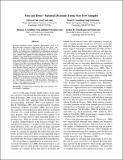| dc.contributor.author | Vul, Edward | |
| dc.contributor.author | Goodman, Noah | |
| dc.contributor.author | Griffiths, Thomas L. | |
| dc.contributor.author | Tenenbaum, Joshua B. | |
| dc.date.accessioned | 2016-05-16T13:30:22Z | |
| dc.date.available | 2016-05-16T13:30:22Z | |
| dc.date.issued | 2014-01 | |
| dc.date.submitted | 2013-03 | |
| dc.identifier.issn | 03640213 | |
| dc.identifier.issn | 1551-6709 | |
| dc.identifier.uri | http://hdl.handle.net/1721.1/102508 | |
| dc.description.abstract | In many learning or inference tasks human behavior approximates that of a Bayesian ideal observer, suggesting that, at some level, cognition can be described as Bayesian inference. However, a number of findings have highlighted an intriguing mismatch between human behavior and standard assumptions about optimality: People often appear to make decisions based on just one or a few samples from the appropriate posterior probability distribution, rather than using the full distribution. Although sampling-based approximations are a common way to implement Bayesian inference, the very limited numbers of samples often used by humans seem insufficient to approximate the required probability distributions very accurately. Here, we consider this discrepancy in the broader framework of statistical decision theory, and ask: If people are making decisions based on samples—but as samples are costly—how many samples should people use to optimize their total expected or worst-case reward over a large number of decisions? We find that under reasonable assumptions about the time costs of sampling, making many quick but locally suboptimal decisions based on very few samples may be the globally optimal strategy over long periods. These results help to reconcile a large body of work showing sampling-based or probability matching behavior with the hypothesis that human cognition can be understood in Bayesian terms, and they suggest promising future directions for studies of resource-constrained cognition. | en_US |
| dc.description.sponsorship | United States. Office of Naval Research. Multidisciplinary University Research Initiative (Grant N00014-07-1-0937) | en_US |
| dc.description.sponsorship | United States. Intelligence Advanced Research Projects Activity (United States. Dept. of Interior Contract D10PC20023) | en_US |
| dc.language.iso | en_US | |
| dc.publisher | Wiley Blackwell | en_US |
| dc.relation.isversionof | http://dx.doi.org/10.1111/cogs.12101 | en_US |
| dc.rights | Creative Commons Attribution-NonCommercial-NoDerivs License | en_US |
| dc.rights.uri | http://creativecommons.org/licenses/by-nc-nd/4.0/ | en_US |
| dc.source | Other univ. web domain | en_US |
| dc.title | One and Done? Optimal Decisions From Very Few Samples | en_US |
| dc.type | Article | en_US |
| dc.identifier.citation | Vul, Edward, Noah Goodman, Thomas L. Griffiths, and Joshua B. Tenenbaum. “One and Done? Optimal Decisions From Very Few Samples.” Cogn Sci 38, no. 4 (January 28, 2014): 599–637. | en_US |
| dc.contributor.department | Massachusetts Institute of Technology. Department of Brain and Cognitive Sciences | en_US |
| dc.contributor.mitauthor | Tenenbaum, Joshua B. | en_US |
| dc.relation.journal | Cognitive Science | en_US |
| dc.eprint.version | Original manuscript | en_US |
| dc.type.uri | http://purl.org/eprint/type/JournalArticle | en_US |
| eprint.status | http://purl.org/eprint/status/NonPeerReviewed | en_US |
| dspace.orderedauthors | Vul, Edward; Goodman, Noah; Griffiths, Thomas L.; Tenenbaum, Joshua B. | en_US |
| dspace.embargo.terms | N | en_US |
| dc.identifier.orcid | https://orcid.org/0000-0002-1925-2035 | |
| mit.license | PUBLISHER_CC | en_US |
| mit.metadata.status | Complete | |
